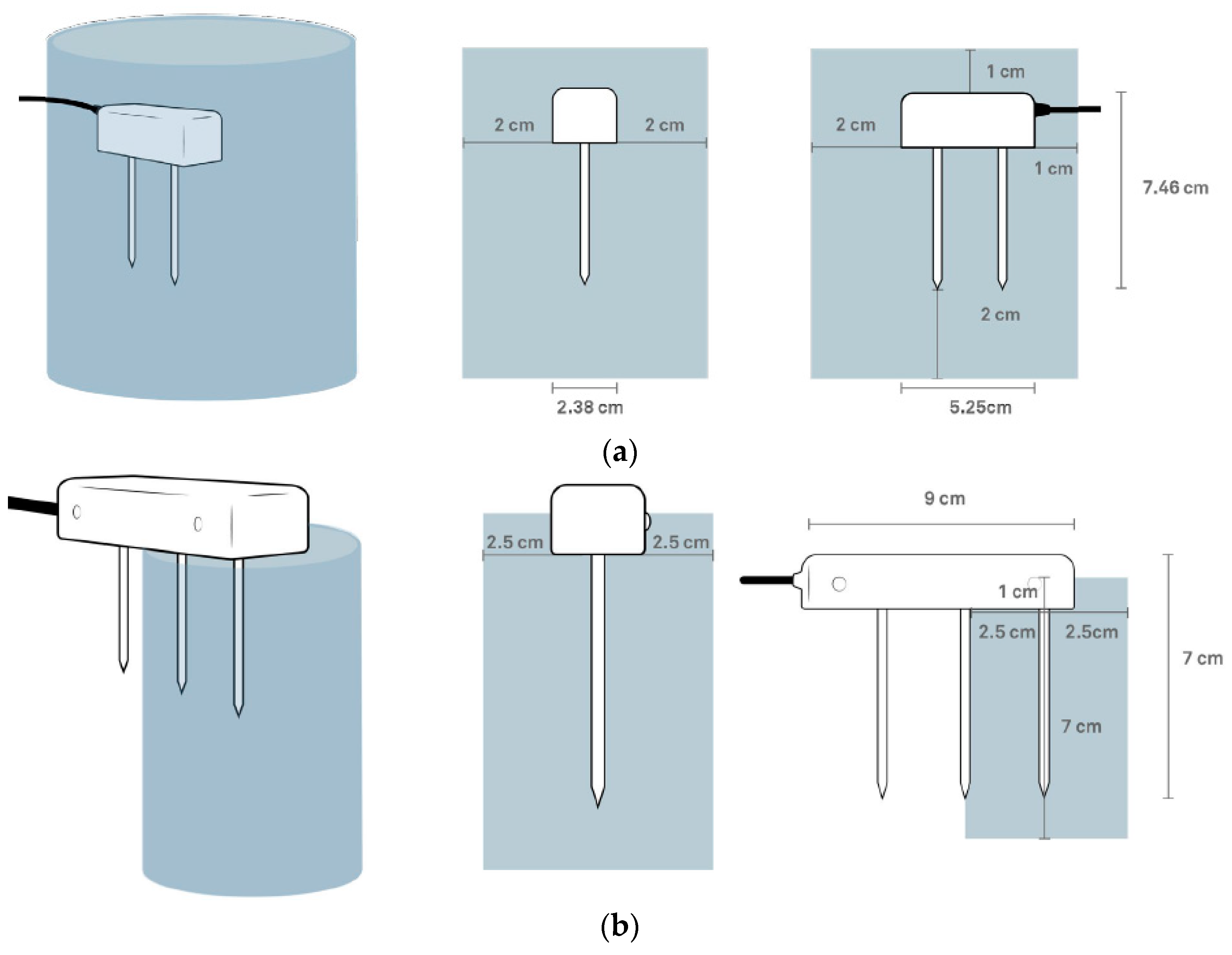The Use of Soil Moisture and Pore-Water Pressure Sensors for the Interpretation of Landslide Behavior in Small-Scale Physical Models
Abstract
1. Introduction
2. Platform for Testing Downscaled Slope Models under 1 g Rainfall Infiltration Conditions
2.1. Slope Model Construction and Soil Properties
2.2. Rainfall Simulator
2.3. Monitoring Equipment
3. Equipment for Monitoring the Hydraulic Response of Slope Models
3.1. Soil Water Content Sensors
3.2. Soil Water Potential Sensors
4. Examples of Measurement Results and Data Interpretation
4.1. Example 1: Initiation of Sandy Slope due to GWL Rise
4.2. Example 2: Hydraulic Paths and a Reduction in the Shear Strength due to Rainfall Infiltration
4.3. Example 3: Initial Soil Moisture Distribution and the Instability Type: Erosion vs. Sliding
5. Conclusions
Author Contributions
Funding
Data Availability Statement
Acknowledgments
Conflicts of Interest
References
- Hinds, E.; Lu, N.; Mirus, B.; Wayllace, A. Effects of Infiltration Characteristics on Spatial-Temporal Evolution of Stability of an Interstate Highway Embankment. J. Geotech. Geoenvironmental. Eng. 2019, 145, 05019008. [Google Scholar] [CrossRef]
- Wang, G.; Sassa, K. Pore-Pressure Generation and Movement of Rainfall-Induced Landslides: Effects of Grain Size and Fine-Particle Content. Eng. Geol. 2003, 69, 109–125. [Google Scholar] [CrossRef]
- Tagarelli, V.; Cotecchia, F. Coupled Hydro-Mechanical Analysis of the Effects of Medium Depth Drainage Trenches Mitigating Deep Landslide Activity. Eng. Geol. 2022, 297, 106510. [Google Scholar] [CrossRef]
- Harris, S.J.; Orense, R.P.; Itoh, K. Back Analyses of Rainfall-Induced Slope Failure in Northland Allochthon Formation. Landslides 2012, 9, 349–356. [Google Scholar] [CrossRef]
- Cotecchia, F.; Pedone, G.; Bottiglieri, O.; Santaloia, F.; Vitone, C. Slope-Atmosphere Interaction in a Tectonized Clayey Slope: A Case Study. Riv. Ital. Geotech. 2014, 1, 34–61. [Google Scholar]
- Collins, B.D.; Znidarcic, D. Stability Analyses of Rainfall Induced Landslides. J. Geotech. Geoenviron. Eng. 2004, 130, 362–372. [Google Scholar] [CrossRef]
- Chen, P.; Lu, N.; Formetta, G.; Godt, J.W.; Wayllace, A. Tropical Storm-Induced Landslide Potential Using Combined Field Monitoring and Numerical Modeling. J. Geotech. Geoenviron. Eng. 2018, 144, 05018002. [Google Scholar] [CrossRef]
- Cascini, L.; Cuomo, S.; Pastor, M.; Sorbino, G. Modeling of Rainfall-Induced Shallow Landslides of the Flow-Type. J. Geotech. Geoenviron. Eng. 2010, 136, 85–98. [Google Scholar] [CrossRef]
- Cascini, L.; Calvello, M.; Grimaldi, G.M. Groundwater Modeling for the Analysis of Active Slow-Moving Landslides. J. Geotech. Geoenviron. Eng. 2010, 136, 1220–1230. [Google Scholar] [CrossRef]
- Casagli, N.; Dapporto, S.; Ibsen, M.L.; Tofani, V.; Vannocci, P. Analysis of the Landslide Triggering Mechanism during the Storm of 20th-21st November 2000, in Northern Tuscany. Landslides 2006, 3, 13–21. [Google Scholar] [CrossRef]
- Alonso, E.E.; Gens, A.; Delahaye, C.H. Influence of Rainfall on the Deformation and Stability of a Slope in Overconsolidated Clays: A Case Study. Hydrogeol. J. 2003, 11, 174–192. [Google Scholar] [CrossRef]
- Alonso, E.E. Triggering and Motion of Landslides. Geotechnique 2021, 71, 3–59. [Google Scholar] [CrossRef]
- Iverson, R.M. Landslide Triggering by Rain Infiltration. Water Resour. Res. 2000, 36, 1897–1910. [Google Scholar] [CrossRef]
- Moriwaki, H.; Inokuchi, T.; Hattanji, T.; Sassa, K.; Ochiai, H.; Wang, G. Failure Processes in a Full-Scale Landslide Experiment Using a Rainfall Simulator. Landslides 2004, 1, 277–288. [Google Scholar] [CrossRef]
- Rahardjo, H.; Ong, T.H.; Rezaur, R.B.; Leong, E.C. Factors Controlling Instability of Homogeneous Soil Slopes under Rainfall. J. Geotech. Geoenviron. Eng. 2007, 133, 1532–1543. [Google Scholar] [CrossRef]
- Lu, N.; Godt, J. Infinite Slope Stability under Steady Unsaturated Seepage Conditions. Water Resour. Res. 2008, 44, 1–13. [Google Scholar] [CrossRef]
- Chen, P.; Mirus, B.; Lu, N.; Godt, J.W. Effect of Hydraulic Hysteresis on Stability of Infinite Slopes under Steady Infiltration. J. Geotech. Geoenviron. Eng. 2017, 143, 04017041. [Google Scholar] [CrossRef]
- Tsiampousi, A.; Zdravkovic, L.; Potts, D.M. Numerical Study of the Effect of Soil–Atmosphere Interaction on the Stability and Serviceability of Cut Slopes in London Clay. Can. Geotech. J. 2017, 54, 405–418. [Google Scholar] [CrossRef]
- Pedone, G.; Tsiampousi, A.; Cotecchia, F.; Zdravkovic, L. Coupled Hydro-Mechanical Modelling of Soil–Vegetation–Atmosphere Interaction in Natural Clay Slopes. Can. Geotech. J. 2022, 59, 272–290. [Google Scholar] [CrossRef]
- Cascini, L.; Sorbino, G.; Cuomo, S.; Ferlisi, S. Seasonal Effects of Rainfall on the Shallow Pyroclastic Deposits of the Campania Region (Southern Italy). Landslides 2014, 11, 779–792. [Google Scholar] [CrossRef]
- Greco, R.; Comegna, L.; Damiano, E.; Guida, A.; Olivares, L.; Picarelli, L. Hydrological Modelling of a Slope Covered with Shallow Pyroclastic Deposits from Field Monitoring Data. Hydrol. Earth Syst. Sci. 2013, 17, 4001–4013. [Google Scholar] [CrossRef]
- Comegna, L.; Damiano, E.; Greco, R.; Guida, A.; Olivares, L.; Picarelli, L. Field Hydrological Monitoring of a Sloping Shallow Pyroclastic Deposit. Can. Geotech. J. 2016, 53, 1125–1137. [Google Scholar] [CrossRef]
- Marino, P.; Santonastaso, G.F.; Fan, X.; Greco, R. Prediction of Shallow Landslides in Pyroclastic-Covered Slopes by Coupled Modeling of Unsaturated and Saturated Groundwater Flow. Landslides 2020, 18, 31–41. [Google Scholar] [CrossRef]
- Rahardjo, H.; Lee, T.T.; Leong, E.C.; Rezaur, R.B. Response of a Residual Soil Slope to Rainfall. Can. Geotech. J. 2005, 42, 340–351. [Google Scholar] [CrossRef]
- Rahardjo, H.; Nio, A.S.; Leong, E.C.; Song, N.Y. Effects of Groundwater Table Position and Soil Properties on Stability of Slope during Rainfall. J. Geotech. Geoenviron. Eng. 2010, 136, 1555–1564. [Google Scholar] [CrossRef]
- Rahardjo, H.; Li, X.W.; Toll, D.G.; Leong, E.C. The Effect of Antecedent Rainfall on Slope Stability. Geotech. Geol. Eng. 2001, 19, 371–399. [Google Scholar] [CrossRef]
- Toll, D.G.; Md Rahim, M.S.; Karthikeyan, M.; Tsaparas, I. Soil-Atmosphere Interactions for Analysing Slopes in Tropical Soils in Singapore. Environ. Geotech. 2016, 6, 361–372. [Google Scholar] [CrossRef]
- Kristo, C.; Rahardjo, H.; Satyanaga, A. Effect of Variations in Rainfall Intensity on Slope Stability in Singapore. Int. Soil Water Conserv. Res. 2017, 5, 258–264. [Google Scholar] [CrossRef]
- Godt, J.W.; Baum, R.L.; Lu, N. Landsliding in Partially Saturated Materials. Geophys. Res. Lett. 2009, 36, 1–5. [Google Scholar] [CrossRef]
- Godt, J.W.; Şener-Kaya, B.; Lu, N.; Baum, R.L. Stability of Infinite Slopes under Transient Partially Saturated Seepage Conditions. Water Resour. Res. 2012, 48, 1–14. [Google Scholar] [CrossRef]
- Ebel, B.A.; Godt, J.W.; Lu, N.; Coe, J.A.; Smith, J.B.; Baum, R.L. Field and Laboratory Hydraulic Characterization of Landslide-Prone Soils in the Oregon Coast Range and Implications for Hydrologic Simulation. Vadose Zone J. 2018, 17, 1–15. [Google Scholar] [CrossRef]
- Cho, S.E.; Lee, S.R. Instability of Unsaturated Soil Slopes Due to Infiltration. Comput. Geotech. 2001, 28, 185–208. [Google Scholar] [CrossRef]
- Kim, J.; Jeong, S.; Regueiro, R.A. Instability of Partially Saturated Soil Slopes Due to Alteration of Rainfall Pattern. Eng. Geol. 2012, 147, 28–36. [Google Scholar] [CrossRef]
- Kang, S.; Lee, S.R.; Cho, S.E. Slope Stability Analysis of Unsaturated Soil Slopes Based on the Site-Specific Characteristics: A Case Study of Hwangryeong Mountain, Busan, Korea. Sustainability 2020, 12, 2839. [Google Scholar] [CrossRef]
- Kang, S.; Cho, S.E.; Kim, B.; Go, G.H. Effects of Two-Phase Flow Ofwater and Air on Shallow Slope Failures Induced by Rainfall: Insights from Slope Stability Assessment at a Regional Scale. Water 2020, 12, 812. [Google Scholar] [CrossRef]
- Ng, C.W.W.; Shi, Q. A Numerical Investigation of the Stability of Unsaturated Soil Slopes Subjected to Transient Seepage. Comput. Geotech. 1998, 22, 1–28. [Google Scholar] [CrossRef]
- Charles, W.W.N.; Pang, Y.W. Influence of Stress State on Soil-Water Characteristics and Slope Stability. J. Geotech. Geoenviron. Eng. 2000, 126, 157–166. [Google Scholar] [CrossRef]
- Leung, A.K.; Ng, C.W.W. Analyses of Groundwater Flow and Plant Evapotranspiration in a Vegetated Soil Slope. Can. Geotech. J. 2013, 50, 1204–1218. [Google Scholar] [CrossRef]
- Lee, L.M.; Gofar, N.; Rahardjo, H. A Simple Model for Preliminary Evaluation of Rainfall-Induced Slope Instability. Eng. Geol. 2009, 108, 272–285. [Google Scholar] [CrossRef]
- Kassim, A.; Gofar, N.; Lee, L.M.; Rahardjo, H. Modeling of Suction Distributions in an Unsaturated Heterogeneous Residual Soil Slope. Eng. Geol. 2012, 131, 70–82. [Google Scholar] [CrossRef]
- Zhang, W.G.; Meng, F.S.; Chen, F.Y.; Liu, H.L. Effects of Spatial Variability of Weak Layer and Seismic Randomness on Rock Slope Stability and Reliability Analysis. Soil Dyn. Earthq. Eng. 2021, 146, 106735. [Google Scholar] [CrossRef]
- Sitarenios, P.; Casini, F.; Askarinejad, A.; Springman, S. Hydro-Mechanical Analysis of a Surficial Landslide Triggered by Artificial Rainfall: The Ruedlingen Field Experiment. Geotechnique 2021, 71, 96–109. [Google Scholar] [CrossRef]
- Comegna, L.; Picarelli, L.; Bucchignani, E.; Mercogliano, P. Potential Effects of Incoming Climate Changes on the Behaviour of Slow Active Landslides in Clay. Landslides 2013, 10, 373–391. [Google Scholar] [CrossRef]
- Lollino, P.; Cotecchia, F.; Elia, G.; Mitaritonna, G.; Santaloia, F. Interpretation of Landslide Mechanisms Based on Numerical Modelling: Two Case-Histories. Eur. J. Environ. Civil. Eng. 2016, 20, 1032–1053. [Google Scholar] [CrossRef]
- Zhao, N.; Hu, B.; Yi, Q.; Yao, W.; Ma, C. The Coupling Effect of Rainfall and Reservoir Water Level Decline on the Baijiabao Landslide in the Three Gorges Reservoir Area, China. Geofluids 2017, 2017, 1–12. [Google Scholar] [CrossRef]
- Tagarelli, V.; Cotecchia, F. The Effects of Slope Initialization on the Numerical Model Predictions of the Slope-Vegetation-Atmosphere Interaction. Geosciences 2020, 10, 85. [Google Scholar] [CrossRef]
- Peranić, J.; Mihalić Arbanas, S.; Arbanas, Ž. Importance of the Unsaturated Zone in Landslide Reactivation on Flysch Slopes: Observations from Valići Landslide, Croatia. Landslides 2021, 18, 3737–3751. [Google Scholar] [CrossRef]
- Tagarelli, V.; Cotecchia, F. Deep Movements in Clayey Slopes Relating to Climate: Modeling for Early Warning System Design. In Lecture Notes in Civil Engineering; Springer: Cham, Switzerland, 2020. [Google Scholar]
- Li, A.G.; Yue, Z.Q.; Tham, L.G.; Lee, C.F.; Law, K.T. Field-Monitored Variations of Soil Moisture and Matric Suction in a Saprolite Slope. Can. Geotech. J. 2005, 42, 13–26. [Google Scholar] [CrossRef]
- Comegna, L.; Damiano, E.; Greco, R.; Olivares, L.; Picarelli, L. The Hysteretic Response of a Shallow Pyroclastic Deposit. Earth Syst. Sci. Data 2021, 13, 2541–2553. [Google Scholar] [CrossRef]
- Springman, S.M.; Thielen, A.; Kienzler, P.; Friedel, S. A Long-Term Field Study for the Investigation of Rainfall-Induced Landslides. Geotechnique 2013, 63, 1177–1193. [Google Scholar] [CrossRef]
- Bordoni, M.; Meisina, C.; Valentino, R.; Lu, N.; Bittelli, M.; Chersich, S. Hydrological Factors Affecting Rainfall-Induced Shallow Landslides: From the Field Monitoring to a Simplified Slope Stability Analysis. Eng. Geol. 2015, 193, 19–37. [Google Scholar] [CrossRef]
- Leung, A.K.; Ng, C.W.W. Field Investigation of Deformation Characteristics and Stress Mobilisation of a Soil Slope. Landslides 2016, 13, 229–240. [Google Scholar] [CrossRef]
- Kim, K.S.; Jeong, S.W.; Song, Y.S.; Kim, M.; Park, J.Y. Four-Year Monitoring Study of Shallow Landslide Hazards Based on Hydrological Measurements in a Weathered Granite Soil Slope in South Korea. Water 2021, 13, 2330. [Google Scholar] [CrossRef]
- Sattler, K.; Elwood, D.; Hendry, M.T.; Huntley, D.; Holmes, J.; Wilkinson, P.B.; Chambers, J.; Donohue, S.; Meldrum, P.I.; Macciotta, R.; et al. Quantifying the Contribution of Matric Suction on Changes in Stability and Displacement Rate of a Translational Landslide in Glaciolacustrine Clay. Landslides 2021, 18, 1675–1689. [Google Scholar] [CrossRef]
- Askarinejad, A.; Casini, F.; Bischof, P.; Beck, A.; Springman, S.M. Rainfall Induced Instabilities: A Field Experiment on a Silty Sandslope in Northern Switzerland. Riv. Ital. Geotec. 2012, 3, 50–71. [Google Scholar]
- Tagarelli, V.; Cotecchia, F. Preliminary Field Data of Selected Deep-Rooted Vegetation Effects on the Slope-Vegetation-Atmosphere Interaction: Results from an in-Situ Test. Ital. Geotech. J. 2022, 1, 62–83. [Google Scholar]
- Krzeminska, D.M.; Bogaard, T.A.; Debieche, T.H.; Cervi, F.; Marc, V.; Malet, J.P. Field Investigation of Preferential Fissure Flow Paths with Hydrochemical Analysis of Small-Scale Sprinkling Experiments. Earth Surf. Dyn. 2014, 2, 181–195. [Google Scholar] [CrossRef]
- Zhang, M.; Yang, L.; Ren, X.; Zhang, C.; Zhang, T.; Zhang, J.; Shi, X. Field Model Experiments to Determine Mechanisms of Rainstorm-Induced Shallow Landslides in the Feiyunjiang River Basin, China. Eng. Geol. 2019, 262, 105348. [Google Scholar] [CrossRef]
- Sun, P.; Wang, H.; Wang, G.; Li, R.; Zhang, Z.; Huo, X. Field Model Experiments and Numerical Analysis of Rainfall-Induced Shallow Loess Landslides. Eng. Geol. 2021, 295, 106411. [Google Scholar] [CrossRef]
- Melinda, F.; Rahardjo, H.; Han, K.K.; Leong, E.C. Shear Strength of Compacted Soil under Infiltration Condition. J. Geotech. Geoenviron. Eng. 2004, 130, 807–817. [Google Scholar] [CrossRef]
- Casini, F.; Serri, V.; Springman, S.M. Hydromechanical Behaviour of a Silty Sand from a Steep Slope Triggered by Artificial Rainfall: From Unsaturated to Saturated Conditions. Can. Geotech. J. 2013, 50, 28–40. [Google Scholar] [CrossRef]
- Cuomo, S.; Moscariello, M.; Foresta, V. Wetting Tests of Partially Saturated Soils under Simple Shear Conditions. Geotech. Lett. 2017, 7, 197–203. [Google Scholar] [CrossRef]
- Peranić, J.; Arbanas, Ž. Impact of the Wetting Process on the Hydro-Mechanical Behavior of Unsaturated Residual Soil from Flysch Rock Mass: Preliminary Results. Bull. Eng. Geol. Environ. 2020, 79, 985–998. [Google Scholar] [CrossRef]
- Take, W.A.; Bolton, M.D.; Wong, P.C.P.; Yeung, F.J. Evaluation of Landslide Triggering Mechanisms in Model Fill Slopes. Landslides 2004, 1, 173–184. [Google Scholar] [CrossRef]
- Tohari, A.; Nishigaki, M.; Komatsu, M. Laboratory Rainfall-Induced Slope Failure with Moisture Content Measurement. J. Geotech. Geoenviron. Eng. 2007, 133, 575–587. [Google Scholar] [CrossRef]
- Greco, R.; Guida, A.; Damiano, E.; Olivares, L. Soil Water Content and Suction Monitoring in Model Slopes for Shallow Flowslides Early Warning Applications. Phys. Chem. Earth 2010, 35, 127–136. [Google Scholar] [CrossRef]
- Montrasio, L.; Schilirò, L.; Terrone, A. Physical and Numerical Modelling of Shallow Landslides. Landslides 2016, 13, 873–883. [Google Scholar] [CrossRef]
- Damiano, E.; Greco, R.; Guida, A.; Olivares, L.; Picarelli, L. Investigation on Rainwater Infiltration into Layered Shallow Covers in Pyroclastic Soils and Its Effect on Slope Stability. Eng. Geol. 2017, 220, 208–218. [Google Scholar] [CrossRef]
- Chueasamat, A.; Hori, T.; Saito, H.; Sato, T.; Kohgo, Y. Experimental Tests of Slope Failure Due to Rainfalls Using 1g Physical Slope Models. Soils Found. 2018, 58, 290–305. [Google Scholar] [CrossRef]
- Spolverino, G.; Capparelli, G.; Versace, P. An Instrumented Flume for Infiltration Process Modeling, Landslide Triggering and Propagation. Geosciences 2019, 9, 108. [Google Scholar] [CrossRef]
- Pajalić, S.; Peranić, J.; Maksimović, S.; Čeh, N.; Jagodnik, V.; Arbanas, Ž. Monitoring and Data Analysis in Small-Scale Landslide Physical Model. Appl. Sci. 2021, 11, 5040. [Google Scholar] [CrossRef]
- Yang, K.H.; Nguyen, T.S.; Rahardjo, H.; Lin, D.G. Deformation Characteristics of Unstable Shallow Slopes Triggered by Rainfall Infiltration. Bull. Eng. Geol. Environ. 2021, 80, 317–344. [Google Scholar] [CrossRef]
- Ladd, R.S. Specimen Preparation and Liquefaction of Sands. J. Geotech. Eng. Div. 1974, 100, 1180–1184. [Google Scholar] [CrossRef]
- Zanutta, A.; Baldi, P.; Bitelli, G.; Cardinali, M.; Carrara, A. Qualitative and Quantitative Photogrammetric Techniques for Multi-Temporal Landslide Analysis. Ann. Geophys. 2006, 49, 1067–1080. [Google Scholar] [CrossRef]
- Feng, T.; Mi, H.; Scaioni, M.; Qiao, G.; Lu, P.; Wang, W.; Tong, X.; Li, R. Measurement of Surface Changes in a Scaled-down Landslide Model Using High-Speed Stereo Image Sequences. Photogramm. Eng. Remote Sens. 2016, 82, 547–557. [Google Scholar] [CrossRef]
- Bitelli, G.; Dubbini, M.; Zanutta, A.; Scanning, L.; Sensing, R. Terrestrial laser scanning and digital photogrammetry techniques to monitor landslide bodies. Int. Arch. Photogramm. Remote Sens. Spat. Inf. Sci. 2004, 38, 246–251. [Google Scholar]
- Topp, G.C.; Davis, J.L.; Annan, A.P. Electromagnetic Determination of Soil Water Content: Measurements in Coaxial Transmission Lines. Water Resour. Res. 1980, 16, 574–582. [Google Scholar] [CrossRef]
- Meter. TEROS 11/12. Available online: http://publications.metergroup.com/Manuals/20587_TEROS11-12_Manual_Web.pdf (accessed on 28 July 2022).
- Meter. TEROS 10. Available online: http://publications.metergroup.com/Manuals/20788_TEROS10_Manual_Web.pdf (accessed on 28 July 2022).
- Meter. TEROS 21 GEN 2. Available online: http://library.metergroup.com/Manuals/20854_TEROS21_Gen2_Manual_Web.pdf (accessed on 29 July 2022).
- Meter. TEROS 31. Available online: http://library.metergroup.com/Manuals/20799_TEROS%2031_Manual_Web.pdf (accessed on 29 July 2022).
- Meter. TEROS 32. Available online: http://library.metergroup.com/Manuals/20786_TEROS32_Manual_Web.pdf (accessed on 29 July 2022).
- Bishop, A.W. The Principle of Effective Stress. Tek. Ukebl. 1959, 39, 859–863. [Google Scholar]
- Dias, A.S.; Pirone, M.; Nicotera, M.V.; Urciuoli, G. Hydraulic Characterization of an Unsaturated Vegetated Soil: The Role of Plant Roots and Hydraulic Hysteresis. Geomech. Energy Environ. 2021, 30, 100235. [Google Scholar] [CrossRef]
- Rianna, G.; Comegna, L.; Pagano, L.; Picarelli, L.; Reder, A. The Role of Hydraulic Hysteresis on the Hydrological Response of Pyroclastic Silty Covers. Water 2019, 11, 628. [Google Scholar] [CrossRef]
- Capparelli, G.; Spolverino, G. An Empirical Approach for Modeling Hysteresis Behavior of Pyroclastic Soils. Hydrology 2020, 7, 14. [Google Scholar] [CrossRef]
- Nicotera, M.V.; Papa, R.; Urciuoli, G. The Hydro-Mechanical Behaviour of Unsaturated Pyroclastic Soils: An Experimental Investigation. Eng. Geol. 2015, 195, 70–84. [Google Scholar] [CrossRef]
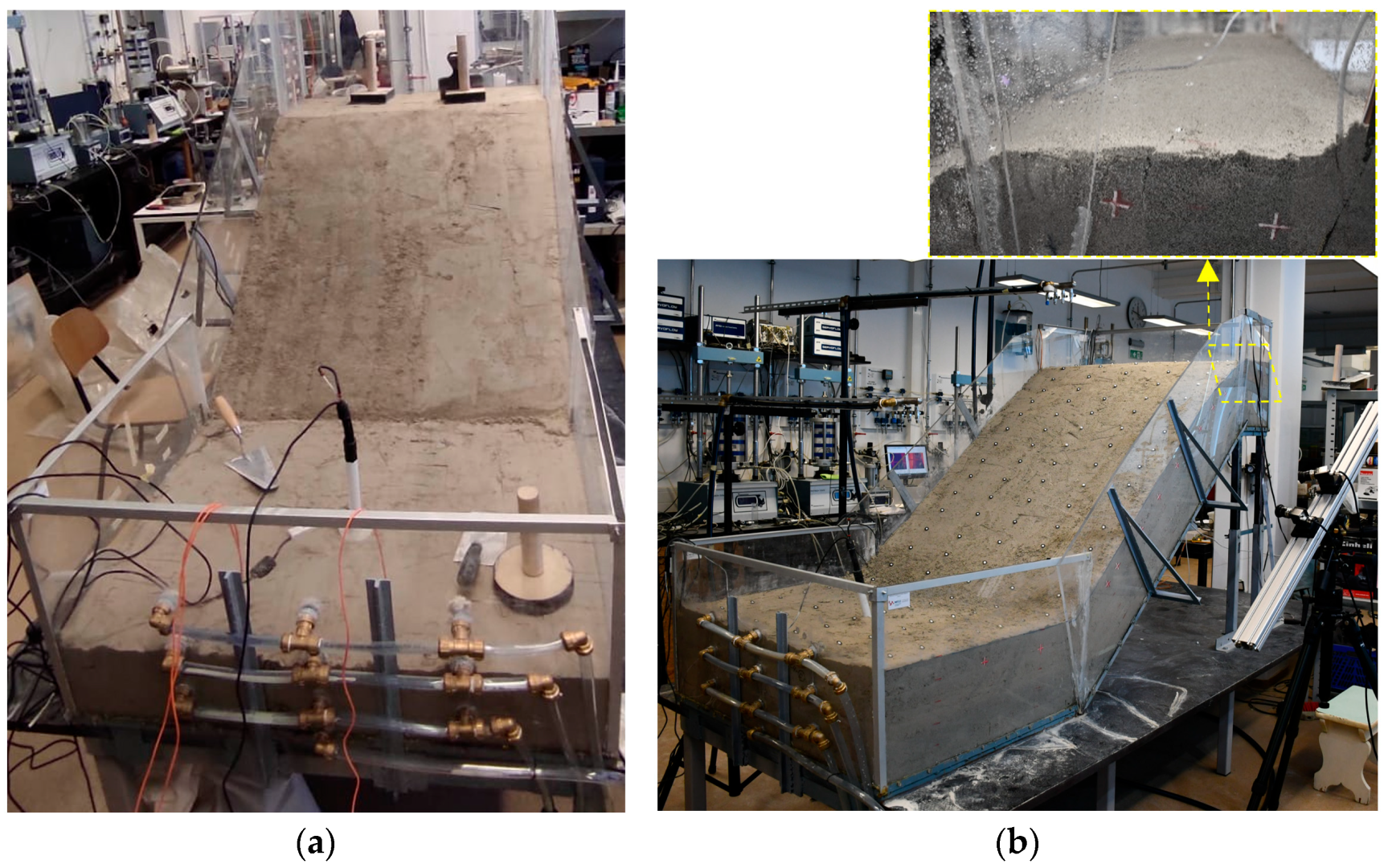
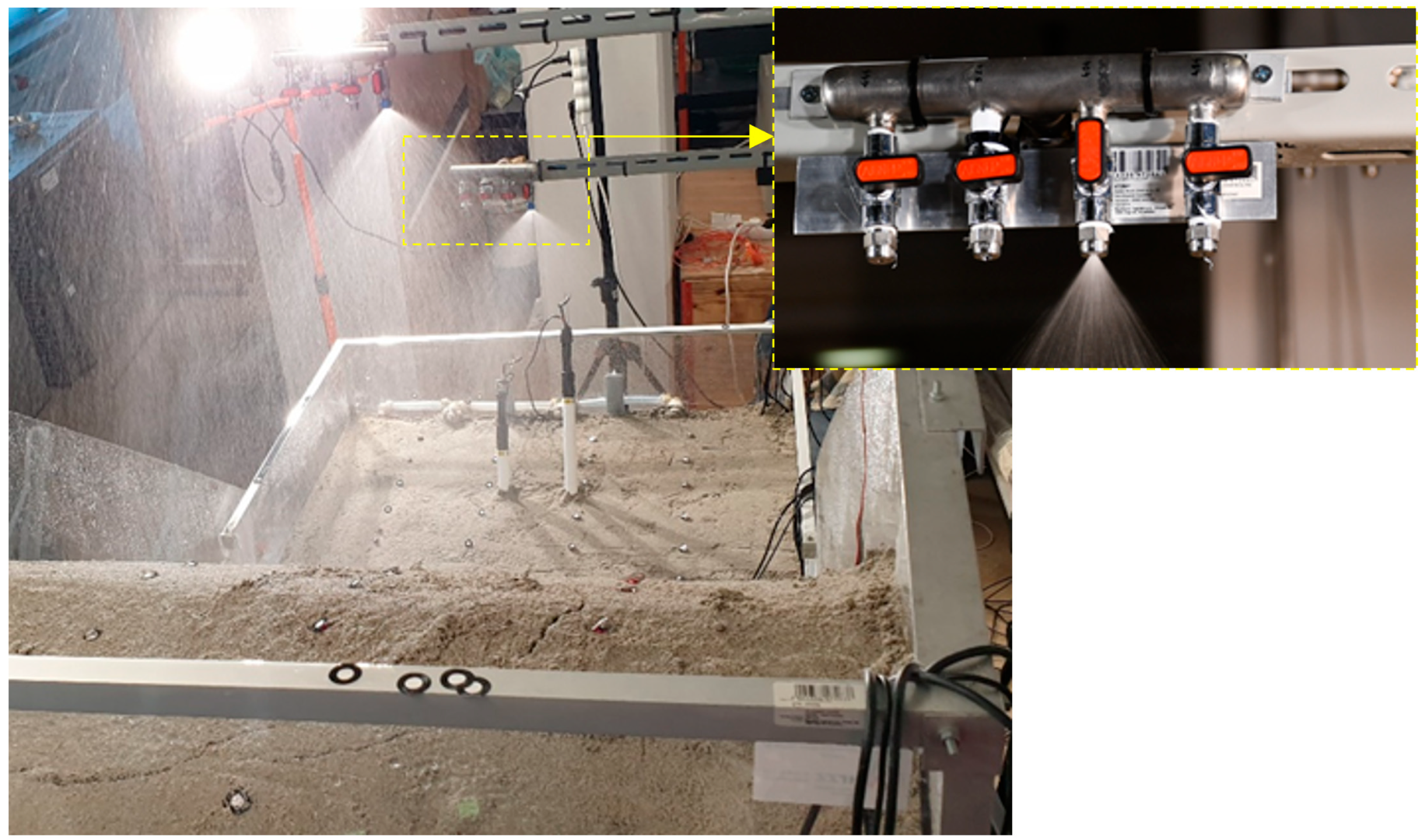
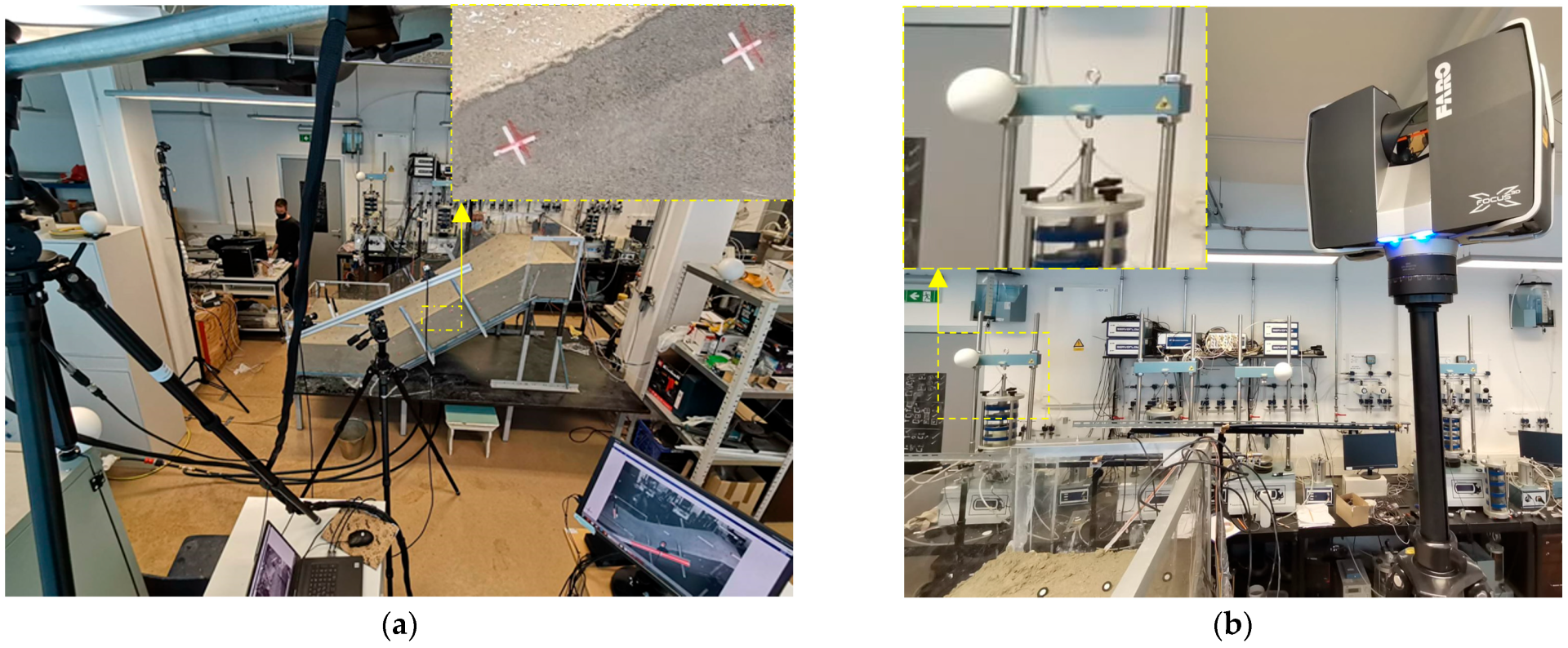


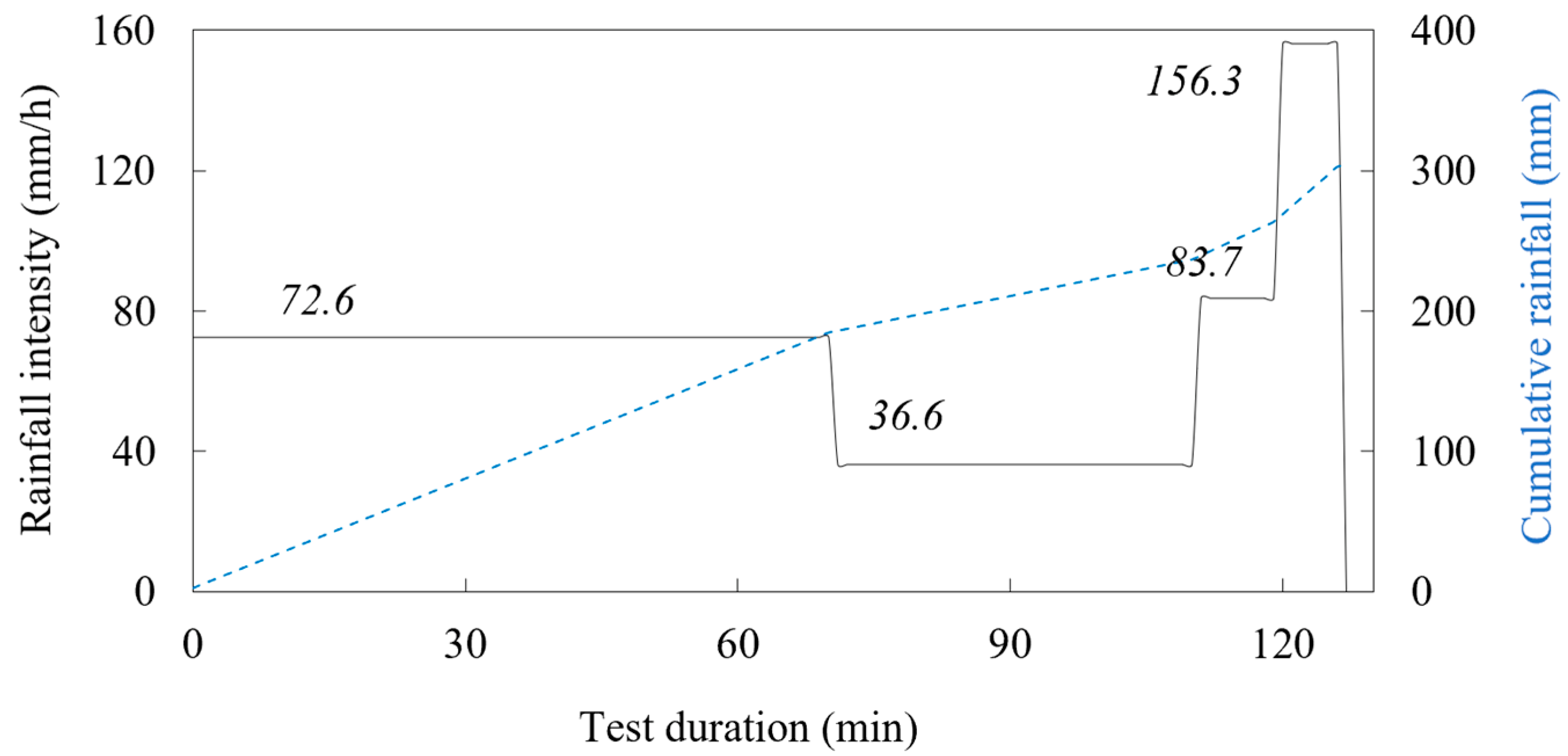


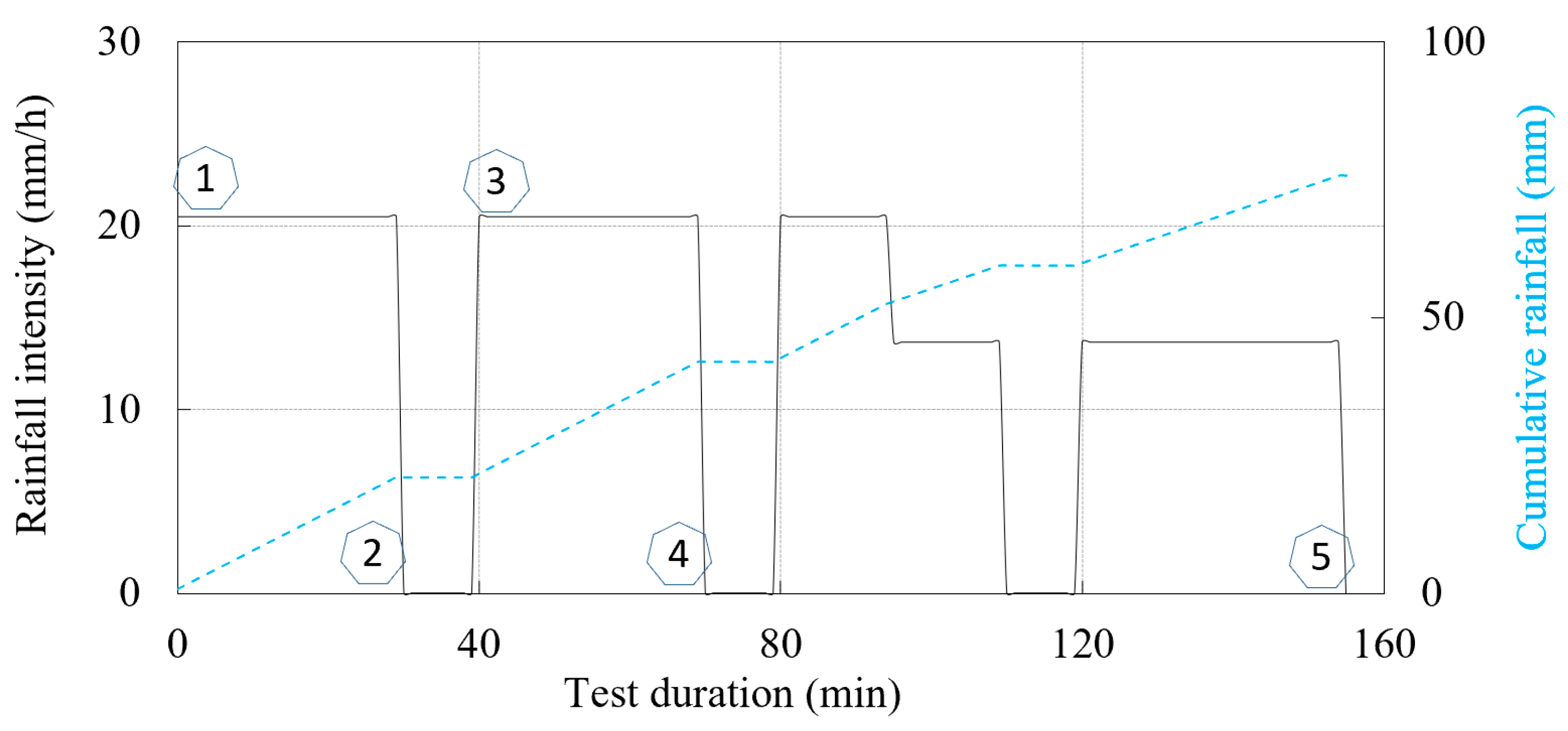

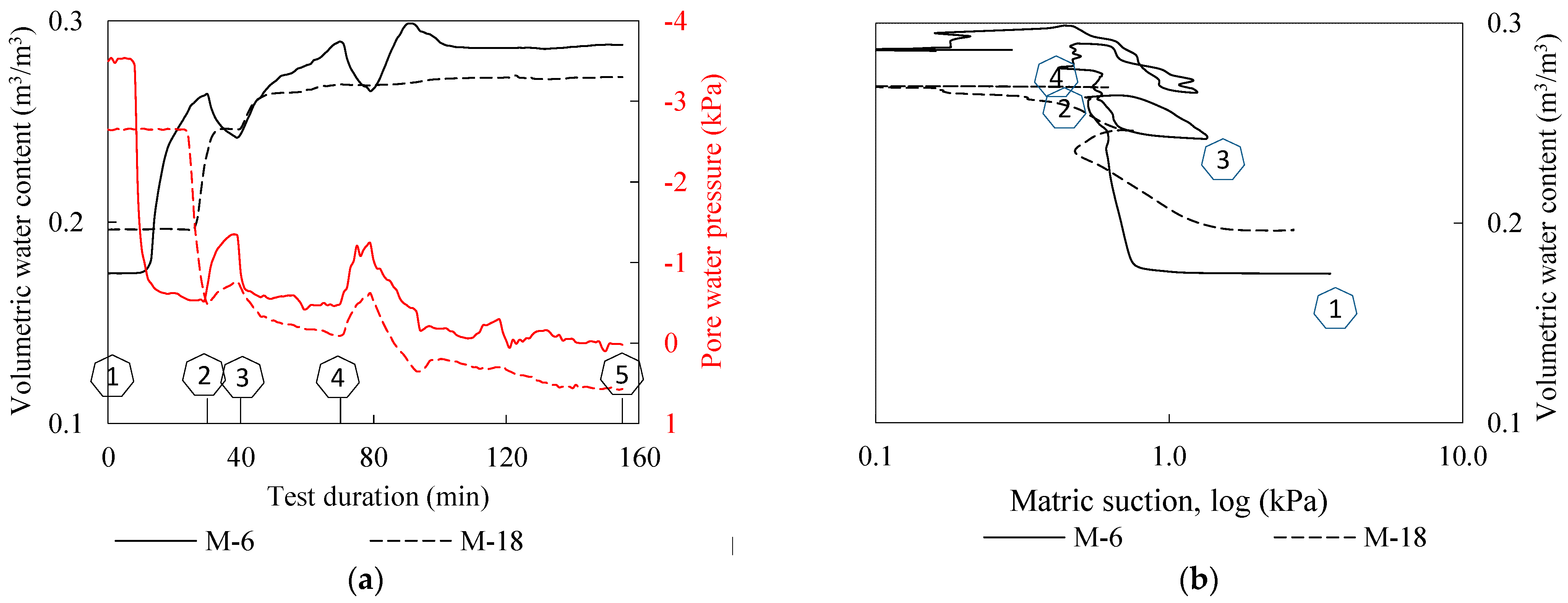

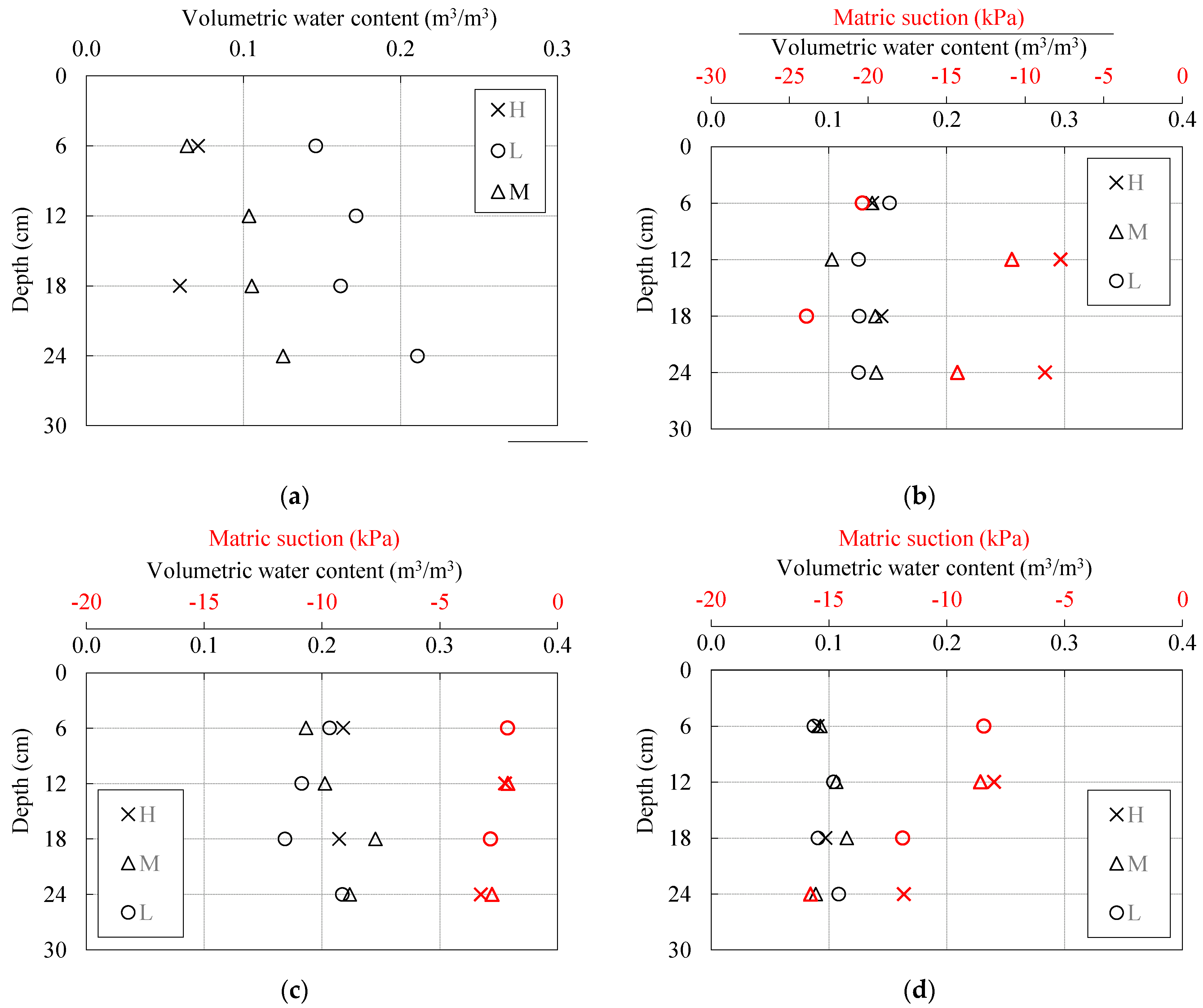
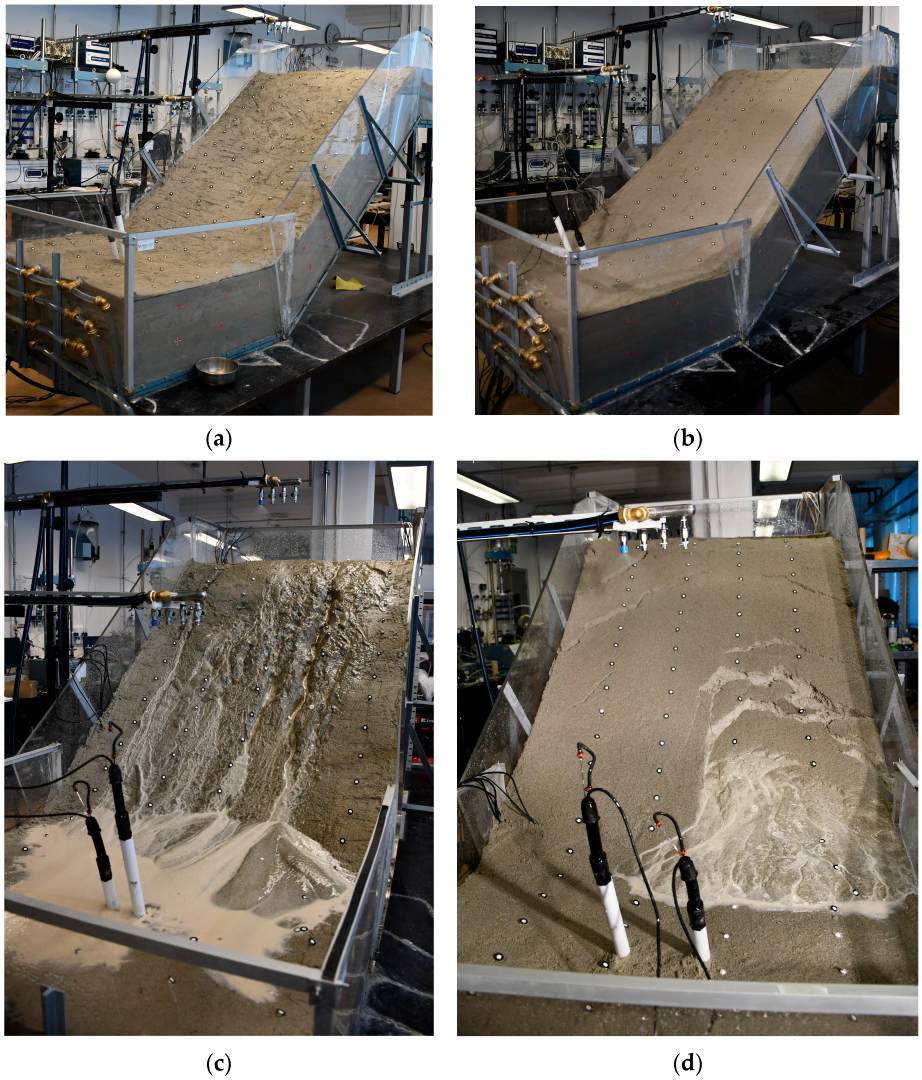
| Material | S | SK10 | SK15 |
|---|---|---|---|
| Specific gravity, Gs (/) | 2.70 | 2.69 | 2.67 |
| Effective particle size | |||
| D10 (mm) | 0.190 | 0.038 | 0.056 |
| D60 (mm) | 0.370 | 0.310 | 0.207 |
| Uniformity coefficient, cu (/) | 1.95 | 8.16 | 54.11 |
| Minimum void ratio, emin (/) | 0.64 | 0.65 | 0.54 |
| Maximum void ratio, emax (/) | 0.91 | 1.21 | 1.43 |
| Hydraulic conductivity 1, ks (m/s) | 1.0 × 10−5 | 6.8 × 10−6 | 3.5 × 10−6 |
| Friction angle 2, ϕ (◦) | 34.9 | 31.3 | 31.8 |
| Cohesion 2, c (kPa) | 0 | 3.9 | 4.4 |
| Targeted initial porosity, ni (/) | 0.44 | 0.47 | 0.43 |
| Targeted initial relative density, Dr (/) | 0.5 | 0.5 | 0.75 |
| Targeted initial water content, wi (%) | 2 | 5 | 8.1 |
| Type | Spray Angle (°) | v (L/min) | ||||
|---|---|---|---|---|---|---|
| p (bar) | 1.0 | 2.0 | 3.0 | 5.0 | ||
| 490.404 | 60 | 0.76 | 1.00 | 1.18 | 1.44 | |
| 490.444 | 60 | 0.95 | 1.25 | 1.47 | 1.80 | |
| 490.484 | 60 | 1.21 | 1.60 | 1.88 | 2.31 | |
| 490.524 | 60 | 1.52 | 2.00 | 2.35 | 2.89 | |
| 460.524 | 90 | 0.30 | 0.40 | 0.47 | 0.58 | |
Publisher’s Note: MDPI stays neutral with regard to jurisdictional claims in published maps and institutional affiliations. |
© 2022 by the authors. Licensee MDPI, Basel, Switzerland. This article is an open access article distributed under the terms and conditions of the Creative Commons Attribution (CC BY) license (https://creativecommons.org/licenses/by/4.0/).
Share and Cite
Peranić, J.; Čeh, N.; Arbanas, Ž. The Use of Soil Moisture and Pore-Water Pressure Sensors for the Interpretation of Landslide Behavior in Small-Scale Physical Models. Sensors 2022, 22, 7337. https://doi.org/10.3390/s22197337
Peranić J, Čeh N, Arbanas Ž. The Use of Soil Moisture and Pore-Water Pressure Sensors for the Interpretation of Landslide Behavior in Small-Scale Physical Models. Sensors. 2022; 22(19):7337. https://doi.org/10.3390/s22197337
Chicago/Turabian StylePeranić, Josip, Nina Čeh, and Željko Arbanas. 2022. "The Use of Soil Moisture and Pore-Water Pressure Sensors for the Interpretation of Landslide Behavior in Small-Scale Physical Models" Sensors 22, no. 19: 7337. https://doi.org/10.3390/s22197337
APA StylePeranić, J., Čeh, N., & Arbanas, Ž. (2022). The Use of Soil Moisture and Pore-Water Pressure Sensors for the Interpretation of Landslide Behavior in Small-Scale Physical Models. Sensors, 22(19), 7337. https://doi.org/10.3390/s22197337






